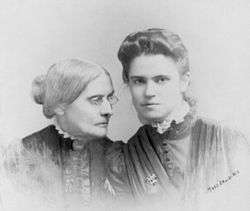Rachel Foster Avery
| Rachel Foster Avery | |
|---|---|
 Rachel Foster Avery (right) and Susan B. Anthony | |
| Born |
Rachel Foster December 30, 1858 Pittsburgh, Pennsylvania |
| Died | October 26, 1919 (aged 60) |
| Nationality | American |
| Occupation | social activist, suffragist |
Rachel Foster Avery (December 30, 1858 – October 26, 1919) was active in the American women's suffrage movement during the late 19th century, working closely with Susan B. Anthony and other movement leaders. She rose to be corresponding secretary of the National American Woman Suffrage Association and played a key role in organizing meetings across the country.[1][2]
Biography
Rachel Foster was born in Pittsburgh, Pennsylvania, to Julia Manuel Foster and J. Heron Foster, the editor of the Pittsburgh Dispatch.[3] She had two sisters, Julia T. Foster and Rachel G. Foster, both of whom were also women's rights activists.[2]
Elizabeth Cady Stanton, a prominent advocate of women's rights and a friend of Foster's mother, held suffrage meetings at the Fosters' home, and Rachel's mother became vice president of the local suffrage society.[2][4] After J. Heron Foster's death in 1868, Rachel, her sister Julia, and her mother moved to Philadelphia, where they joined the Citizens' Suffrage Association.[2]
Foster began writing for newspapers at about age 17, sending letters from California and Europe to the Pittsburgh Leader.[2][4] During this period, she studied at the University of Zurich.[2]
At age 21, she attended the eleventh convention of the National Woman Suffrage Association[3] and became actively involved in its work, planning and organizing more than a dozen of the association's meetings across the country in 1880 and 1881.[2][4]

In 1882, she led the Nebraska campaign for an amendment to permit women to vote.[2][3] Later, she disseminated throughout the state of Pennsylvania some 20,000 copies of a lecture by Governor John Hoyt of Wyoming, entitled "The Good Results of Thirteen Years' Experience of Women's Voting in Wyoming".[2]
In 1883, Foster traveled through Europe with "Aunt Susan", as she called Susan B. Anthony.[2] They traveled through France, Italy, Germany, and Switzerland.[2][4]
In February 1888, Foster organized the International Council of Women[3] in Washington, D. C., held under the auspices of the National Woman Suffrage Association. A major undertaking, the council draw in delegates from more than 50 different organizations from seven countries.[2]
Foster later held the office of corresponding secretary of the National Woman Suffrage Association, of the National Council of Women, and of the International Council of Women.[3][4]
Personal life
In 1887, she adopted a baby girl, whom she named Miriam Alice Foster.[2] On November 8, 1888, Foster married Cyrus Miller Avery (1854-1919), whom she had met when he was a delegate to the International Council of Women meeting earlier the same year.[2] Their marriage was jointly performed by a male pastor, Charles G. Ames of the Unitarian Church, and a female pastor, Anna Howard Shaw, one of the first women to be ordained a Methodist minister in the United States.[2] In addition to Miriam, the couple had two more children, Rose Foster Avery and Julia Foster Avery.[2]
References
- ↑ Susan Magarey, ed. (2006). Ever Yours, C. H. Spence. Wakefield Press. ISBN 1-86254-656-8.
- 1 2 3 4 5 6 7 8 9 10 11 12 13 14 15 16 Willard, Frances E., and Mary A. Livermore, eds. A Woman of the Century: Fourteen Hundred-Seventy Biographical Sketches Accompanied by Portraits of Leading American Women in All Walks of Life, Moulton 1893, pp. 37-38.
- 1 2 3 4 5 Kathryn Cullen-DuPont (1 August 2000). Encyclopedia of women's history in America. Infobase Publishing. p. 19. ISBN 978-0-8160-4100-8. Retrieved 28 November 2011.
- 1 2 3 4 5 Logan, John A (1912). The Part Taken by Women in American History. Perry-Nalle Publishing Co. pp. 586–87.
External links
| Wikimedia Commons has media related to Rachel Foster Avery. |
- Works by or about Rachel Foster Avery in libraries (WorldCat catalog)